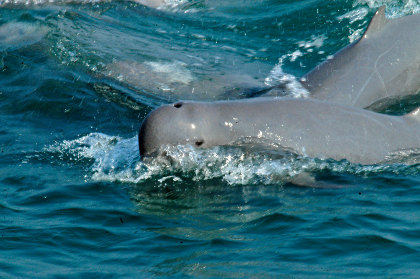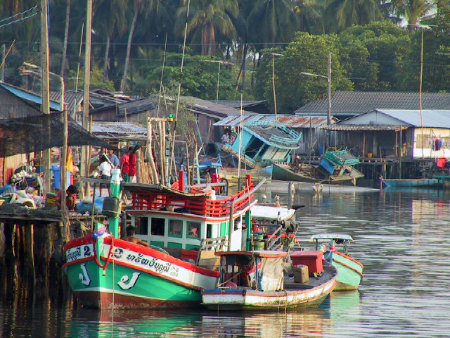
|
Published: 5 September 2011
Conserving Thailand’s whales, dolphins and porpoises
The first detailed study of whales, dolphins and porpoises in Trat Province, along the eastern coast of the Gulf of Thailand, will provide critical information on their abundance and distribution, and management and conservation needs.

|
|
Irrawaddy dolphins in the eastern Gulf of Thailand.
Credit: Somchai Mananunsap
|
Project leader, Associate Professor Ellen Hines of the San Francisco State University in the United States, says Southeast Asia is a priority region for studies on cetacean conservation and small-scale fisheries. This is due to the lack of data on cetacean populations and high by-catch rates of these marine mammals in the fisheries.
Among the species of interest are the Irrawaddy dolphin (Orcaella brevirostris), the Indo-Pacific humpback dolphin (Sousa chinensis) and the finless porpoise (Neophocaena phocaenoides).
‘Our project will be the first in this area to gather data on these vulnerable and near-threatened species, which will be crucial for their management,’ Professor Hines says.
‘The eastern Gulf coast, particularly Chang Island in Trat province, has few protected areas and is becoming increasingly popular with tourists and gradually overfished.’
Professor Hines and her team will work closely with federal, provincial and local government departments, scientists, fishermen, villagers and students to collect and disseminate information. The information will contribute to local management plans and the International Union for the Conservation of Nature’s (IUCN) Conservation Action Plan for the World’s Cetaceans.
The collaboration will build on the team’s strong links with the community, established during eight years of research in the region.
The study will involve boat-based surveys, photo identification, spatial habitat modelling, beach surveys, and interviews with villagers about their cultural and traditional knowledge and conservation values.

|
|
A local fishing village in the eastern Gulf of Thailand.
Credit: Ellen Hines
|
‘We will use boat-based surveys to investigate the spatial distribution and abundance of coastal cetaceans, to study patterns of habitat use and how this influences their potential interactions with fisheries, and to study cetacean behaviour, group dynamics and movement patterns,’ Professor Hines says.
The photo-identification work will identify individual animals through fin markings, enabling the team to estimate home ranges and movement in and out of areas.
Geographic Information Systems and statistical modelling will be used to study the relationship between observed cetacean location and environmental variables such as salinity, water temperature, depth, and the presence of nets and fishing vessels. Beach surveys will look for cetacean remains that can provide tissue samples for genetic and physical analysis.
Interviews with community members will determine the number of fishermen using different fishing practices and their catch species. The interviews will also address the history and possible cultural relationship between cetaceans and coastal villagers, stranding locations and numbers, patterns of movement and sightings, and unsustainable fishing practices.
‘Conservation must address the needs and values of local human populations. Studying various dimensions of the human socioeconomic system, and how that influences human use of the environment can shed light on options for cetacean conservation and management,’ Professor Hines says.
In addition to formal conservation measures, the research results will be used to produce educational materials for school and village outreach programs that address basic cetacean ecology and marine conservation issues.
The three-year project is being funded through the Indo-Pacific Cetacean Research and Conservation Fund, administered by the Australian Antarctic Division’s Australian Marine Mammal Centre in Hobart.
This article was supplied courtesy of the Australian Antarctic Division and will be published in Antarctic Magazine, December 2011.



